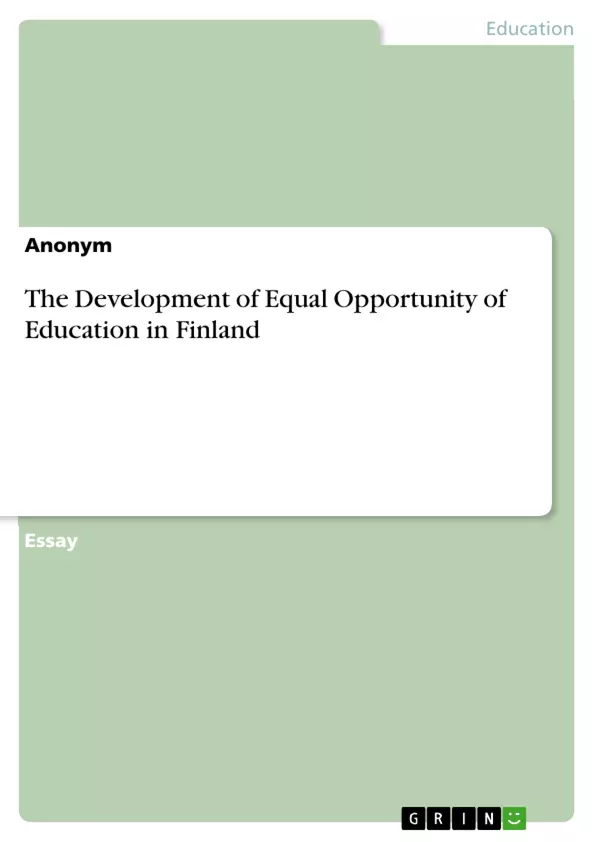"The Finnish education system offers everybody equal opportunities for education, irrespective of domicile, sex, economic situation or linguistic and cultural background. The school network is regionally extensive, and there are no sex-specific school services. Basic education is completely free of charge (...)." (FINNISH NATIONAL BOARD OF EDUCATION, 2009)
Since the 19th century the Finnish society and its socio-economic as well as political conditions have undergone an extensive development until the educational system has reached its current state which is described in the given quote by the Finnish National Board of Education. Within the scope of these developments, the idea of equality in education has been interpreted differently by different agents in different times. There had been two important reform periods with their own definitions of equality in education: the formation of the comprehensive school in the 1960s/70s and the changes in the school system influenced by neo-liberalist economics in the 1980s/90s (AHONEN, 2002: 173). The aim of this essay is to examine especially these two different approaches towards equality in education in the 20th century. However, in order to set the frame for these milestones in the Finnish educational history, a short historical outline about the rise of mass education in Finland is given first.
Inhaltsverzeichnis (Table of Contents)
- The Development of Equal Opportunity of Education in Finland
- A Short Historical Outline about the Rise of Mass Education in Finland
- The Formation of the Comprehensive School
- The Changes in the School System Influenced by Neo-liberal Economics
- Conclusion
Zielsetzung und Themenschwerpunkte (Objectives and Key Themes)
The essay aims to explore the evolution of equal opportunity in education in Finland during the 20th century, focusing on the two major reform periods: the introduction of the comprehensive school system in the 1960s and 1970s and the neo-liberal influenced reforms of the 1980s and 1990s. It investigates how these different approaches shaped the understanding and implementation of equality in education.
- The historical development of mass education in Finland
- The emergence and implementation of the comprehensive school system
- The influence of neo-liberalism on education policy and its impact on equality
- The changing interpretations of equality in education
- The potential sources of inequality in the current Finnish education system
Zusammenfassung der Kapitel (Chapter Summaries)
- The essay starts by outlining the historical development of education in Finland, tracing its roots from the influence of the state church to the establishment of a more secular system in the 19th century. This chapter highlights key milestones in the development of mass education, such as the introduction of compulsory education in 1921.
- This chapter delves into the creation of the comprehensive school system in the 1960s and 1970s. It examines the political and social context that led to this reform, including the increasing demand for a more educated workforce and the recognition of the potential of the previously underprivileged population. The chapter also discusses the criticisms voiced by the universities and grammar school teachers concerning the potential impact of this reform.
- This chapter analyzes the changes in the Finnish education system brought about by the rise of neo-liberal economics in the 1980s and 1990s. It discusses how the understanding of equality in education shifted towards an individual's right to education based on their talents, leading to the rationalization and increased flexibility of the comprehensive school system. The chapter details specific policy changes, including the introduction of school choice and the abolishment of fixed catchment areas.
Schlüsselwörter (Keywords)
The essay explores the historical development of equal opportunity in education in Finland, focusing on the influence of different political and economic ideologies. Key terms include: comprehensive school system, neo-liberalism, equality in education, social and regional disparities, mass education, compulsory education, and educational reforms.
- Citar trabajo
- Anonym (Autor), 2009, The Development of Equal Opportunity of Education in Finland, Múnich, GRIN Verlag, https://www.grin.com/document/158939



